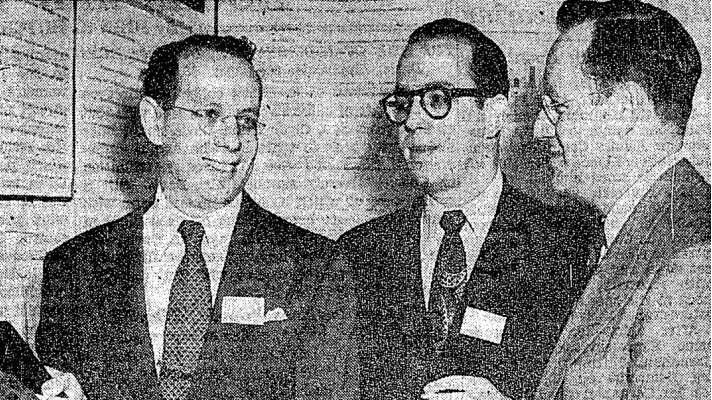On Monday the 15th, the Oxford University announced that the family name US Sackler will be removed from the buildings and scholarships named in his honor, despite the million-dollar donations they have made to the institution.
LOOK: Oppenheimer: the persecuted genius who detonated the world
In this way, the prestigious English university joins a list that also includes institutions such as the British Museum, the National Gallery, the Victoria and Albert Museum or the Tate Gallery, where the name Sackler has been practically banned.
Through a statement, from Oxford they explained that the name Sackler will remain in the donor records “in order to record historical donations to the university.”
It is known that several rooms of the renowned Ashmolean museum of art and archeology, located in the heart of Oxford, as well as a series of scholarships bore the name of the Sacklers.
But, who are the Sacklers and what has unleashed this wave of repudiation against them?
A DARK FORTUNE
Arthur, Mortimer and Raymond Sackler were born during the first two decades of the 20th century into a family of European Jews who settled in the New York borough of Brooklyn.
Curiously, all three showed a broad interest in the human mind, which led to two of them becoming psychiatrists and the third brother becoming a psychologist. The Sacklers coincided at the Creedmoor Psychiatric Center in Queens as their first job, there they were recognized for practicing controversial lobotomies, those rudimentary surgical interventions that planned to alleviate some psychological condition.
By 1952 the three brothers acquired a small pharmaceutical company called Purdue-Frederick whose unattractive products began to sell thanks to the marketing skills of Arthur Sackler. The key, apparently, was targeting their advertising at doctors and getting some psychiatrists to give the products their stamp of approval.

After the death of the eldest of the brothers, in 1987 Mortimer and Raymond renamed the company Purdue Pharma, the same one that a decade later, in 1996, introduced OxyContin to the market. This drug, made on the basis of oxycodone, was very similar to Eukodal, a drug that had been withdrawn from the market in 1990 for generating too much addiction.
OxyContin, on the other hand, is still available to this day.
The prestigious American journalist Patrick Radden Keefe, author of the book “The empire of pain: the secret history of the dynasty that reigned in the pharmaceutical industry”, estimates that the Sacklers amassed a fortune of 35 billion dollars since 1996 thanks to the sale of OxyContin.
THE OPIOID CRISIS
Until a few years ago, the Sackler surname was mainly linked to philanthropy and support for culture. For decades they had made million-dollar donations to prestigious institutions.
From the Guggenheim Museum in New York to the Louvre in Paris to the British Museum in London, all had received hundreds of millions of dollars from the Sacklers.
At the same time, the surname was constantly mentioned in civil and criminal complaints during the first decade of the 2000s, a situation that led Purdue Pharma to disburse around 600 million dollars until 2014 in repairs and fines. The scandal, however, never stopped breaking out.
However, a complaint changed everything. In 2018, the Massachusetts prosecutor filed a civil lawsuit against the Sackler family and Purdue Pharma for finding them guilty of unleashing the opioid crisis that between 1999 and 2019 has caused more than 500,000 overdose deaths in the United States.
According to the indictment, the Sacklers devised deceptive advertising campaigns to hide the true dangers of using oxycodone, including its highly addictive level.

Radden Keefe assured in an interview with the Spanish outlet Ethic that the Sacklers “created an army of hundreds of sales representatives who said over and over again” that OxyContin was not addictive, and that they also “distributed false studies that suggested this idea and they invited doctors to wine and dinner” to recommend their product.
With the investigations on top, Purdue Pharma filed for bankruptcy, although the New York bankruptcy court later determined that they had transferred most of their funds to companies in tax havens to avoid a million-dollar fine. Despite this, the court established that the Sacklers had to pay 4.5 billion dollars to those affected by their products.
The agreement was finally sealed in 2022, with the Sacklers paying some 6 billion dollars to the victims and signing a kind of agreement that granted them some immunity from these types of complaints.
An agreement that, with difficulty, will be able to erase the shadows that already surround this surname.
Source: Elcomercio
I am Jack Morton and I work in 24 News Recorder. I mostly cover world news and I have also authored 24 news recorder. I find this work highly interesting and it allows me to keep up with current events happening around the world.

:quality(75)/cloudfront-us-east-1.images.arcpublishing.com/elcomercio/6IZW64QHDRH7NIWZE5MTOQRDUE.jpg)

:quality(75)/cloudfront-us-east-1.images.arcpublishing.com/elcomercio/COZWC2CYCVDHHP6WJYU3C64OVQ.jpg)
:quality(75)/cloudfront-us-east-1.images.arcpublishing.com/elcomercio/2JXAFYCGCVEFJB7YIGWKSC3YRI.jpg)
:quality(75)/cloudfront-us-east-1.images.arcpublishing.com/elcomercio/BTWMBPK2EJGLDKPSOTDDDNV7EU.jpg)
:quality(75)/cloudfront-us-east-1.images.arcpublishing.com/elcomercio/QLN46J2NXZFU3K5BM7SOVTPJPI.jpg)
